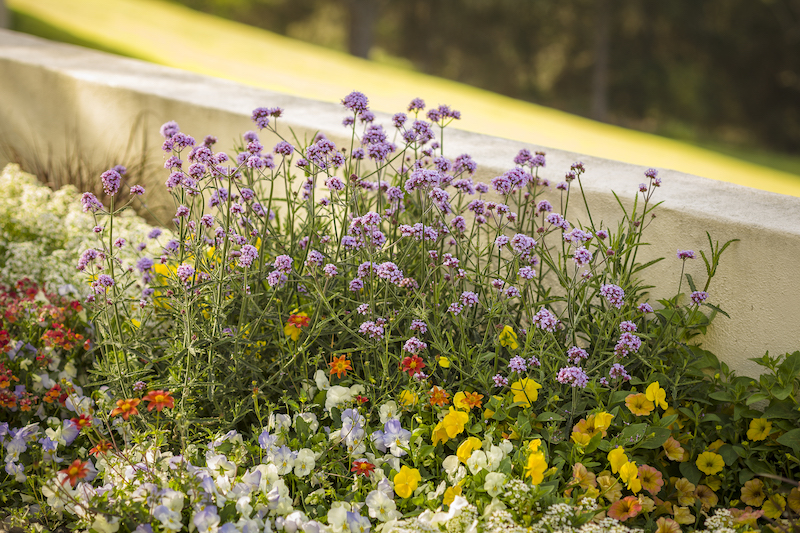Verbena comes in a wide variety of types. The hardy upright Verbena bonariensis and V. vervaine thrive in open locations with full sun and moderately moist soil. The annual varieties can grow well in a variety of locations and can fill in gaps when early annuals and bulbs eventually give into the heat of summer. Annual Verbena comes in a kaleidoscope of single- and bi-colored flowers and will bloom nonstop until late into fall.

Perennial Verbena is considered a classic cottage garden plant and blooms from early summer to fall. It adds height and has an airy look, towering over most other medium-height perennials. The growing conditions this plant prefers are similar to many other plants and include full sun, good drainage, and moderately moist, fertile soil. Annual Verbena blooms better when fed regularly through the growing season either with monthly applications of diluted liquid fertilizers or an application of a granular slow-release formula at planting time.
Shrubs To Plant With Verbena
Many different shrubs blend well with both perennial and annual Verbena. The perennial types can be interplanted between a formal hedge of summer bloomers such as Dogwood, Artemisia, Smokebush, and Weigela. Use annual Verbena as a low-growing layer in front of evergreen shrubs in a foundation planting, or interspersed in a Mediterranean garden with lavender, rosemary, and thyme. The base of deciduous shrubs is also a great spot to plant annual Verbena to act as a ground cover or garden bed border. Hydrangeas and Clethra look particularly nice with a profusely blooming annual Verbena in a complementary color at its feet.
Perennials To Plant With Verbena
Sun-loving herbaceous perennials make ideal companions for perennial Verbena. Ornamental grasses, Jerusalem Sage, coneflower, fox lily, and Agastache are made for pairing with the tall, delicate stems of Verbena, which provide graceful movement in the slightest of breezes. Grow annual Verbena at the front of a border with Coreopsis, lamb’s ear, Gaura, and African daisy. Verbena’s wide range of colors means that the gardener can change the color scheme every spring if desired.

Annuals To Plant With Verbena
Verbena is a queen of the hot season annuals. It is easy to pair with a wide variety of annuals to give your garden just the look you want. Color combinations of whites and greens are cooling during the heat of high summer. Use the brighter bi-colored flowers in your garden for a jolt of early summer color to last for many months until the first frost in fall. Some of the best bloomers include Petunias, Angelonia, Wax and Tuberous Begonia, Nemesia, and Calibrachoa, which will fill in bare spots left by early spring perennials after they go dormant. Use purple fountain grass and ColorBlaze coleus for bright foliage next to verbena.
Best Companion Plants For Verbena in Containers
Verbena can be tucked into just about any container due to its shallow root structure that does not spread aggressively. Choose plants with varied textures such as Papyrus Reed Grass, Calibrachoa, Artemisia, Tuberous Begonias, Gaura, and annual Verbena, which together make a refreshing focal point for any deck or patio.

Monthly fertilizing will be necessary for planters that are densely planted. Choose a liquid formulation of Seaweed or fish emulsion to provide a balance of macronutrients.
Plants Not To Grow With Verbena
Very few plants are incompatible with either perennial or annual Verbena. Keep in mind that to flower well, Verbena will demand at least 6 hours of full sun exposure, either in the morning or afternoon. Containers grown in morning sun and afternoon shade will require less watering. Do not try to grow Verbena in full shade or boggy soil conditions. Ferns, Hostas, and bleeding hearts require too much shade for Verbena to grow well. Likewise, bog plants require too much moisture and should not be grown with Verbena.
Best Plants To Grow With Verbena
The ideal neighbors for perennial Verbena will highlight its graceful height and airy flowers; try pairing it with ornamental grasses, whirling butterflies, and coneflowers. For container designs, choose colors that either contrast or complement your container, with many great options among Petunias, Coleus, Wax Begonias, ornamental grasses, and Nemesia. For a low-maintenance mixed border, plant dogwoods, weigela and smokebush with verbena.
 |
Author Robbin Small - Published 9-07-2023 |




